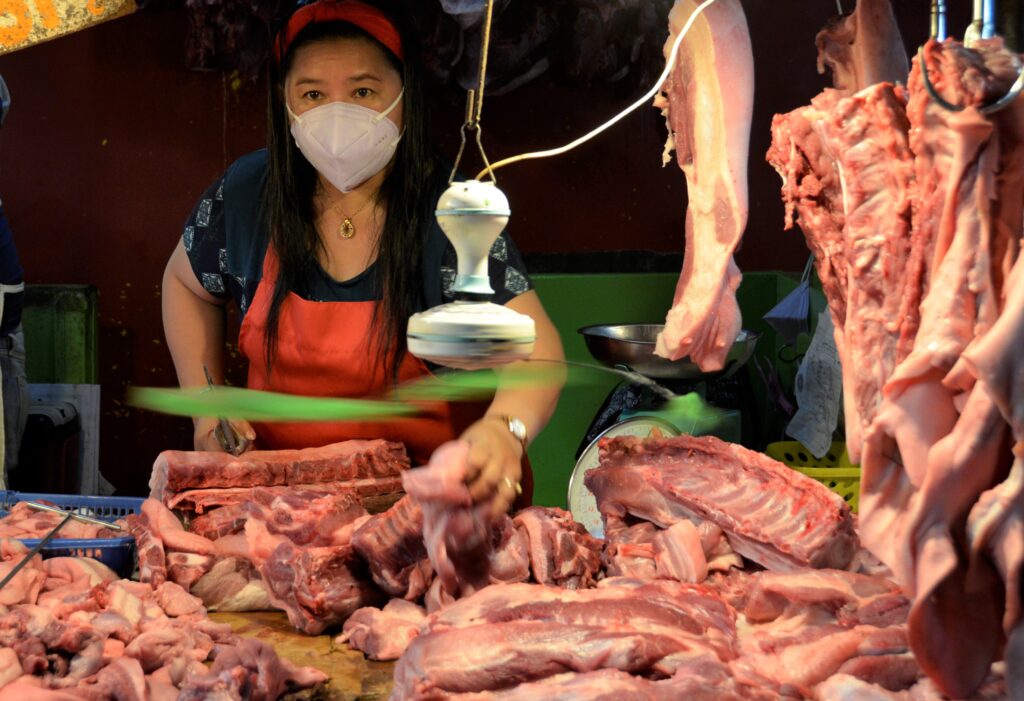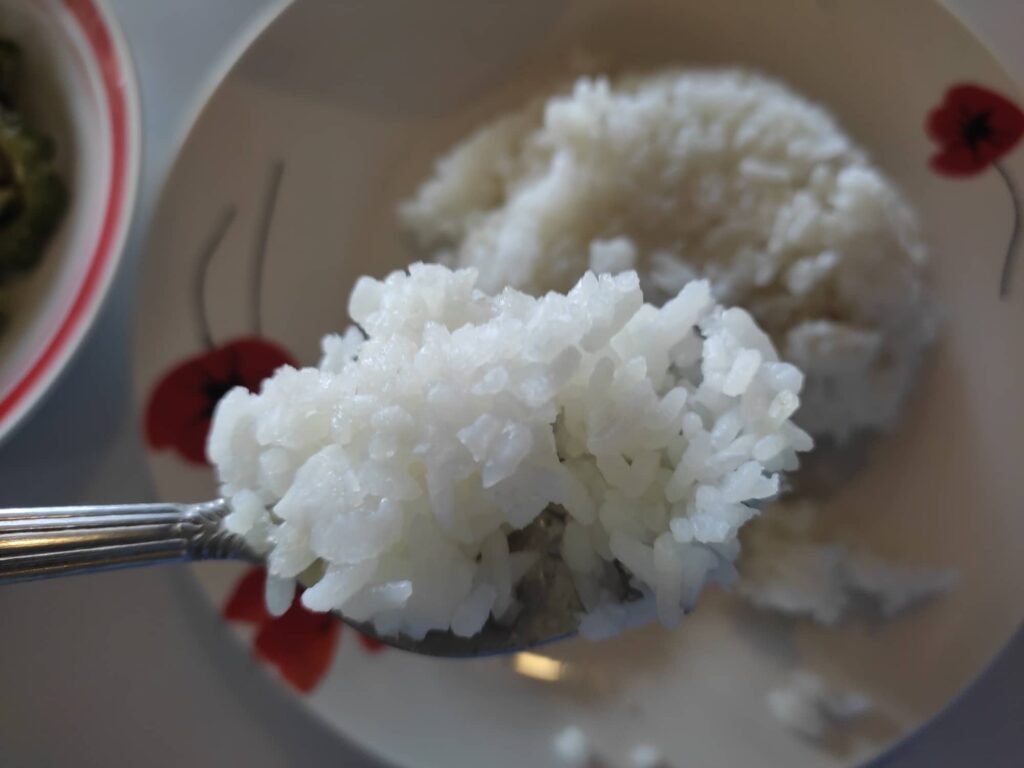Text and Photos by Henrylito D. Tacio
“Food is literally the most important thing in the world. It is not even next to life, because it is life itself. Deprived of the right to food, man knows no other. For the hungry, there is no dignity, no human rights, no rule of law, no liberty, no celebration of the spirit… the most crucial task before the world community today is to assure that enough food is available at the right place, at the right time, and at the right price.” – Arturo R. Tanco, Jr., president of World Food Council
***
“One more rice, please!”
That call, which rings at dinner time in all restaurants and small eateries, best sums up the eating habits of the typical Filipino to whom eating is a matter of filling up. Viand, after all, is expensive while rice is not.
Since most people can’t fill up with ulam, they fill up their consumption with rice. Studies have shown that one-half cup of rice can furnish 82 calories of energy, enough to give someone energy to walk 26 minutes.
Although rice is basically a complex carbohydrate, its protein contains all eight of essential amino acids and complements the amino acids found in many other foods. Low in sodium and fat, with no cholesterol or gluten, it is a boon to weight conscious and those allergic to other grains. It is also low in fiber and easily digested.
In the Philippines, rice is the staple food, along with fish. In fact, rice seems to represent life itself. “Rice is everywhere, in our language as metaphor,” said noted novelist F. Sionil Jose. Thus, if you want to tell someone that he still has a lot of growing up to do intellectually, you would say, “Marami ka pang bigas na kakainin.”
“During the colonization period, rice became a symbol of the power of the landlord over the tenant,” wrote national scientist Gelia T. Castillo, a rural sociologist. “In times of scarcity, only tutong and lugaw are eaten; hence, the lack of rice has become the symbol of poverty. In the theater, rice portrays our politics and our economics.”
Despite the popularity of burgers these days among the non-poor and the proliferation of fast-food outlets, most Filipinos still consider a meal incomplete without rice.
On average, Filipinos consume 114-120 kilograms of rice per capita per year. That’s almost double the world average of 65 kilograms per capita per year, according to Dr. Eufemio Rasco, Jr., former director of the Philippine Rice Research Institute.
In a survey done for the World Bank, it was found that eighty-percent of all respondents consumed rice three or more times a day. Sixteen percent said they ate rice twice a day while only one percent said once. Most of those who ate rice thrice a day belonged to the middle class (81%) and the rich (79%).
“If we did not have rice, our deepest comfort food, we would probably feel less Filipino,” said the late food epicure Doreen Fernandez.
Unfortunately, Filipinos waste rice. Based on 2008 data, the Food and Nutrition Research Institute (FNRI) – a line agency of the Department of Science and Technology (DOST) – every Filipino wastes an average of 3 tablespoons (9 grams) of rice daily, which is equivalent to 3.3 kilograms per year.
The International Rice Research Institute (IRRI) based in Los Baños, Laguna, said the P23 million worth of rice wasted daily, which is enough to feed 4.3 million people.
Rice, along with vegetables and meat, were the top three most wasted foods among Filipino households, according to a new FNRI study.
The data used for the study, “Does plate waste matter?: A two-stage cluster survey to assess the household plate waste in the Philippines,” was from 20,151 Filipino households who participated in the 2018 Expanded National Nutrition Survey (ENNS).
The ENNS was a cross-sectional, population-based survey that characterizes the health and nutritional status of the Filipino population which was conducted by the DOST-FNRI from February to December 2018.
In the study, the factors attributed to rice, vegetables, and meat plate wastage are larger household meal portion size, greater number of household members, and higher wealth status.
Filipino households with the highest rice consumption are more likely to have rice wastage compared to households with the lowest consumption, according to the study.
The study also found there are more foods wasted in households with five or more members, and those residing in rural areas. Rice wastage is also more common in households with a household head whose age ranges from 50–69 years old, than those with a younger household head.
In the Philippines, vegetable consumption is estimated at only 39 kilograms per capita, well below the 146-182 kilograms per capita recommended by the United Nations agencies. After all, most Filipinos use vegetables as only a small part of a meat or fish dish and very seldom as a meal in itself.
Despite the less consumption of vegetables, Filipinos still waste those vegetables being consumed.
The FNRI study said that households with the highest vegetable consumption were more likely to waste vegetables compared to those with the lowest consumption. This implies that households incur more wastes when higher quantities are purchased, which most probably are not consumed and end up being thrown away due to spoilage.
Households composed of five or less members were found to have greater chances of wasting vegetables, which mirrors the results of a previous study which found that larger households were more efficient in meal consumption.
Filipinos consume around 25 kilograms of meat per year. Pork tops the list (15 kilograms), followed by chicken (11.6 kilograms) and finally beef (3 kilograms). On average, Filipinos eat 98 grams of fish per day and 36 kilograms of fish per year. Fish is the cheapest source of animal protein compared to beef, pork and chicken in the country.
The FNRI study showed fish, meat, and poultry plate waste was less likely in households with less than or equal to five members than in households with more than five members.
Households belonging to the richest quintile were found to have greater plate waste compared to the poorest quintile. Past studies exhibited the same, where higher income households were found to waste more food than lower-income households.
“This may be explained by the fact that higher-income households consume diets that tend to include more perishable items,” explained Geraldine Bulaon-Ducusin of S&T Media. “Some of the waste can be explained by food spoiling before the household has a chance to eat it.”
In the Philippines, plate waste is closely linked to hunger incidence and threatened food security. The Global Hunger Index of 2018 scored the Philippines 69 of 119 countries, with a serious level of hunger incidence.
“Millions of Filipinos under poverty and experiencing food insecurity are struggling to be fed, and the food that is simply thrown away or discarded might actually be enough to feed them,” said Dr. Imelda Angeles Agdeppa, lead researcher, Director IV and Scientist IV of DOST-FNRI.
Plate waste also generally emits a portion of the total global greenhouse gas emissions that impact on global warming.
“When food ends up in a landfill, it creates methane, a greenhouse gas 25 times more potent than carbon dioxide,” explained the Commission for Environmental Cooperation. “In fact, if global food waste were measured as a country, it would be the world’s third worst emitter of greenhouse gases.”
Data released by the United Nations Environment Program showed one-third – about 1.3 billion tons – of food produced around the world annually “gets lost or wasted.”
Dr. Adgeppa cited that the results reinforce the need for new strategies to focus on reducing plate waste, which is beneficial from a nutritional, economic, and environmental point of view.
The study suggests that a more effective strategy for reducing food waste may be to train people to prepare and select less food (portion and meal size reduction) and to formulate more policies tackling waste-reduction programs.
Dr. Agdeppa emphasized that both public and private sectors have a role to play to address global food shortages and food wastes considering that more people are getting hungry globally despite the availability of food sufficient for everyone. – ###
Photo captions:
1 Some Filipinos cooked rice more than they can eat.
2 Some homemakers buy vegetables which they cannot actually cook.
3 Meat like pork are thrown away if they cannot be consumed.




